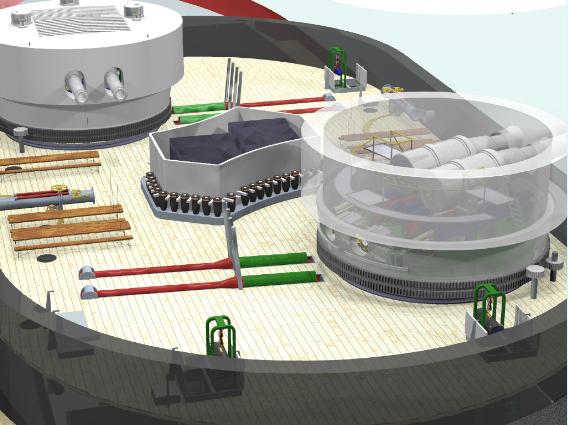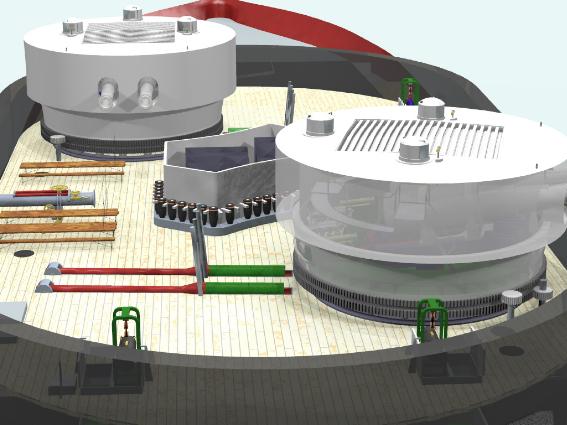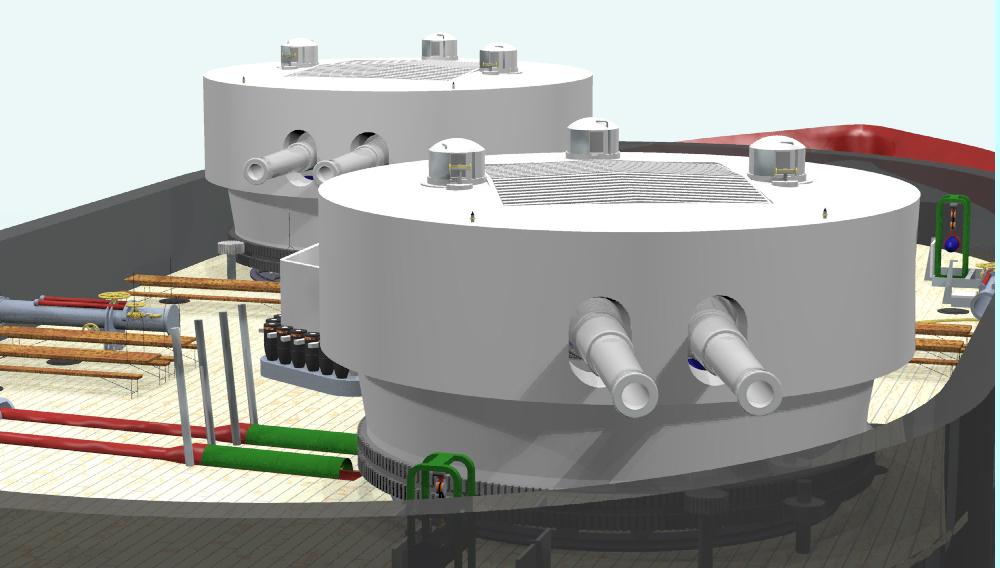| Home | Wiki | Docs | Sources | Contact |

| TURRETS (2) |  |  |
|
Turrets The turrets had 14 inches of compound armour where they rose above the armoured citadel, thickened to 16 inches at the turret front, backed by a layer of teak to absorb splinters. In this view of the gun deck, we can see the mess tables for the crew, probably gunners or stokers. Ready use shells were mounted in frames around the funnel structure. These would most likely to be Palliser or armour piercing shells, and not the ‘common’ shell that carried a considerable explosive charge. Note also the black coaling hatches on port and starboard side. Coaling was a frequent and dirty evolution. Coal in hundred-weight (112 pound) sacks would be swung aboard from an adjacent lighter, barrowed to a deck hatch, and poured in. If the upper deck hatches were above the gun deck hatches, one would imagine there would be canvas trunks to direct the falling coal, otherwise coal would form piles on the gun deck and have to be shovelled and barrowed to the nearest bunker hatch. Very messy indeed, especially as a number of the crew lived in this space. There is also a risk of the coal dust jamming the moving parts of the turret and reloading equipment. |
 |
|
Both turrets now have the armoured roof with the three viewing ports and sights. The central port was occupied by the Captain of the Turret, and the gun Number 1s looked out from the left and right ports. Tangent sights can be seen mounted just in front of each port. The roof of the turret was ventilated by a series of T frames which allowed smoke to escape after firing. In practice, smoke from the guns usually dissipated well before the breeches were opened as the turrets slowly trained to their loading position. It appears that access to the turrets was made through the turret roof via ladders let down from the flying deck bridging the space between the two main superstructures, or possibly rungs welded to the turret itself to allow access from the upper deck. |

|


The armoured citadel and gun deck was capped by a three inch armoured deck which did not extend beyond the citadel. An armoured glacis ring surrounding each turret was intended to prevent glancing shot from penetrating the gap between the upper deck and turret side.
Colossus had a low freeboard – the upper deck is only 9 ft above the water line, and thus it is likely that large seas would sweep the upper deck. To prevent (or minimise) the ingress of water through the gap between the upper deck glacis rung and the turret, flexible (canvas) covers were fitted. Part of the drill for bring the guns to the ready state included unfastening these covers so that the turret can revolve without damaging them.
|
This profile of Colossus shows the flying decks which provided safe traversal between structures in rough weather and which permitted access to the turrets by ladder. Anti-torpedo boat guns (e.g. Nordenfelt) were mounted in the blisters around the funnel and also in the fighting tops on each mast. The extensions visible in the middle of each catwalk were torpedo director positions. |

|
 |  | ||
| (c) 2008 Rob Brassington, all rights reserved | |||